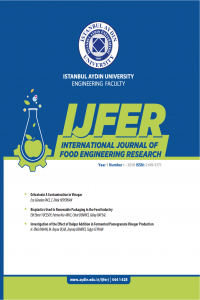GLUTEN-FREE BREAD PRODUCTION FROM CORN AND DETERMINATION OF SENSORY PROPERTIES
GLUTEN-FREE BREAD PRODUCTION FROM CORN AND DETERMINATION OF SENSORY PROPERTIES
Bread is a product that is produced mainly from grains such as wheat, barley and oats and is consumed
in many societies as a staple food. However, due to gluten causing small bowel disease
called celiac, extensive research is being done on producing bread from gluten-free raw materials
such as corn and rice. In this study, the sensory properties of breads produced using corn flour, and
corn flour together with corn starch were investigated. The addition of corn starch to corn flour
had a positive effect on both the rheological and sensory characteristics of bread and was more
appreciated by panelists. Continuing the studies on gluten-free bread production using different
gluten-free raw materials is important in terms of meeting the needs of celiac patients.
___
- [1] Kalkışım, Ö., Özdemir, M., & Bayram, O. (2012). Ekmek Yapım Teknolojisi. Gümüşhane Üniversitesi Yayınları.
- [2] Demirçeken, F. G. (2011). Gluten enteropatisi (çölyak hastalığı): Klasik bir öykü ve güncel gelişmeler. Güncel Gastroenteroloji, 15(1), 58-72.
- [3] Lionetti, E., Leonardi, S., Franzonello, C., Mancardi, M., Ruggieri, M., & Catassi, C. (2015). Gluten psychosis: confirmation of a new clinical entity. Nutrients, 7(7), 5532-5539.
- [4] Kalaycı, G.A. (2000). Celiac Disease. 19 Mayıs University Medical Journal. 17(2): 129- 132.
- [5] Arendt, E., K., O’Brien, C, M, Schober, T., J., Gallagher, E., Gormley, T., R. (2002). Development of gluten free cereal products. Farm Food 21-26.
- [6] Torbica, A., Hadnađev, M., & Hadnađev, T. D. (2012). Rice and buckwheat flour characterisation and its relation to cookie quality. Food Research International, 48(1), 277-283.
- [7] Alvarez-Jubete, L., Arendt, E. K., & Gallagher, E. (2009). Nutritive value and chemical composition of pseudocereals as gluten-free ingredients. International Journal of Food Sciences and Nutrition, 60(sup4), 240-257.
- [8] Capriles, V. D., & Arêas, J. A. G. (2014). Novel approaches in gluten‐free breadmaking: interface between food science, nutrition, and health. Comprehensive Reviews in Food Science and Food Safety, 13(5), 871-890.
- [9] O’Shea, N., Arendt, E., & Gallagher, E. (2014). State of the art in gluten‐free research. Journal of food science, 79(6), R1067-R1076.
- [10] Anonymous, (2012). Notifications on Bread and Bread Varieties, No:2012/2, Turkish Food Codex, Ankara.
- [11] Anonymous, (2011). Notifications on Gluten-Free Foods, No:2003/33, Turkish Food Codex, Ankara.
- [12] Lending, C. R., & Larkins, B. A. (1989). Changes in the zein composition of protein bodies during maize endosperm development. The Plant Cell, 1(10), 1011-1023.
- [13] Smith, S., Cooper, M., Gogerty, J., Loeffler, C., Borcherding, D., Wright, K. (2014). In Yield Gains in Major U.S. Field Crops, Maize: Chapter 6. CSSA Special Publications. 33:125-172.
- [14] Shukla, R., & Cheryan, M. (2001). Zein: the industrial protein from corn. Industrial crops and products, 13(3), 171-192.
- [15] Fimognari, C., Berti, F., Nüsse, M., Cantelli-Forti, G., & Hrelia, P. (2004). Induction of apoptosis in two human leukemia cell lines as well as differentiation in human promyelocytic cells by cyanidin-3-O-β-glucopyranoside. Biochemical pharmacology, 67(11), 2047-2056.
- [16] Matsumoto, M., Hara, H., Chiji, H., & Kasai, T. (2004). Gastroprotective effect of red pigments in black chokeberry fruit (Aronia melanocarpa Elliot) on acute gastric hemorrhagic lesions in rats. Journal of Agricultural and food Chemistry, 52(8), 2226-2229.
- ISSN: 2149-5777
- Başlangıç: 2015
- Yayıncı: İstanbul Aydın Üniversitesi
